
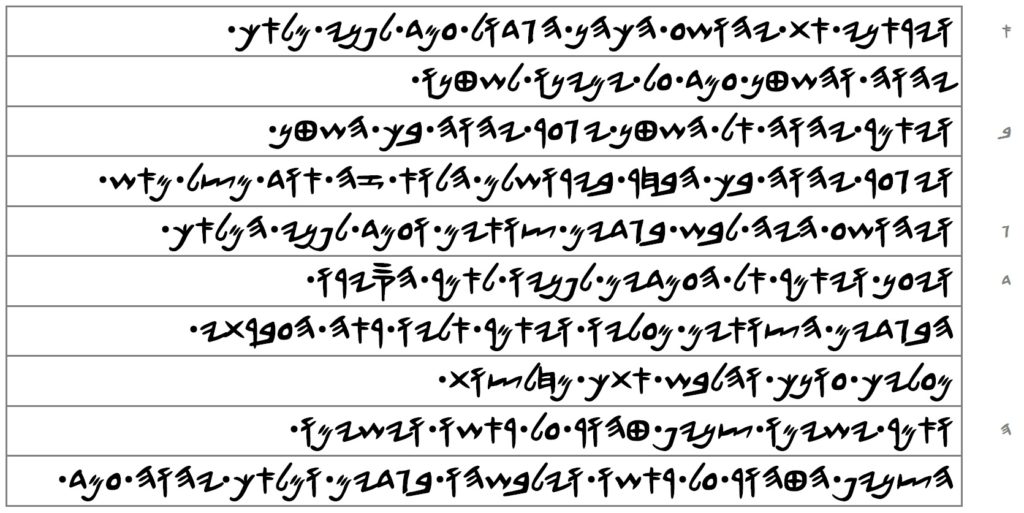
[1] And he showed me Ya’ohshai the High Priest, the one standing before the messenger of YA’OH, and the shatan is standing upon his right hand to shatan him.
[2] And YA’OH said to the shatan: YA’OH will rebuff in you, the shatan, and YA’OH has rebuffed in you; the one who chose Yaroshalam, is not this a firebrand delivered from the fire?
[3] And Ya’ohshai was dressed in filthy clothes, and he stood before the messenger.
[4] And he answered and he said to the ones standing before him, saying: Remove you all the filthy clothes from upon him. And he said unto him: Look, I have caused to pass from upon you your iniquity, and causing to clothe you in splendid clothes.
[5] And he said: Let them set a pure mitre upon his head. And they set the pure mitre upon his head, and they clothed him with garments as the messenger of YA’OH stood.
COMMENTARY OF ZACHAR-YA’OH 3:1-3
[Verse 1] Ya’ohshai Ban Ya’oh-tsadak is the man seen by the prophet Zachar-Ya’oh in his fourth vision. His grandfather, Shar-Ya’oh (Seraiah), was the chahn ha-gadol (‘the High Priest’) who had been taken captive after the sacking of the city of Yaroshalam (Jerusalem) in 587 BCE and burning of the Temple in 586 BCE. Shar-Ya’oh was subsequently slain by the Babylonian King Nabochadnezzar at Riblah (2 Kgs. 25:18-21). Ya’oh-tsadak, the son of Shar-Ya’oh, was at the same time taken captive to Babylon (1 Chron. 6:15), where his son Ya’ohshai was born. During the lifetime of Ya’oh-tsadak, while the Temple was in ruins and the people were in exile, the High Priesthood was in complete abeyance. The return of the exiles to the promised land in 519 BCE which was authorized by a decree of Cyrus the Great meant that the time had come for the office of the High Priesthood to be restored.
However, given the vicissitudes of life in exile, with our captive people being surrounded by idolatry and paganism, and with the temptation to transgress our own laws everywhere one looked in Babylonia, the shatan found reasons from Ya’ohshai’s personal life as to why his nomination as the chahn ha-gadol to succeed Shar-Ya’oh should not be approved. The accusations leveled against Ya’ohshai by the shatan were evidently weighty and severe.
The word shatan in verses 1-2 is not a proper name since it is prefixed by the definite article ha- (‘the’). Proper names do not take the definite article in our language. The word just means adversary. The definite article indicates that a specific and well-known adversary is in view, and thus this person must be the same shatan mentioned in the Book of Ay’ob (Job 1:6-12; 2:1-7). Despite his seeming immortality he is not a fallen angel. There are no such things as fallen angels. The shatan is a hominid created by YA’OH from the ground on the Sixth Day of Creation just as Adam and all other land animals were created from the ground on the Sixth Day (Thorah 1.1:24-31). Adam gave names to all of the animals (Thorah 1.2:15). To the shatan, Adam gave the name nakhash (‘to hiss’) because the shatan could talk and reason just like man, but the shatan talked with a hissing sound. Even though snakes cannot talk Adam gave the snake the same name he gave the shatan because the snake also makes a hissing sound. There was never a talking snake. There was an intelligent, talking hominid.
Adam and his wife Khoh (Eve) were expelled from the garden but nothing is said about the shatan being expelled which means he had access to the tree of life which gives immortality. Why would YA’OH allow the adversary of Adam to eat from that tree and become an immortal being? Because YA’OH had plans to use him as a slave, as a dog on a leash, and that is all he is. He is not at war with YA’OH. He does not go around thwarting the plans of YA’OH. He does only what he is told he can do, and he cannot do anything of his own volition unless it is approved by YA’OH. We see this clearly in the Book of Ay’ob where the shatan could not touch Ay’ob until YA’OH said so (Job 2:5-6). At the end of it all, it was YA’OH who caused all of the affliction Ay’ob suffered. He used the shatan as an instrument to cause all of Ay’ob’s afflictions (Job 42:11).
But why? Why make all that evil happen to a good man? Because the shatan charged Ay’ob with being good only because of the goodness YA’OH bestowed upon him. Take that goodness away, argued the shatan, and he will stop being good. YA’OH proved him wrong and then blessed Ay’ob with even more than he had before his troubles began.
It is no surprise that the shatan of ancient days is seen here in the prophet’s vision opposing the confirmation of Ya’ohshai Ban Ya’oh-tsadak. That is his purpose: to point out the flaws and, and only with permission, to unbalance the equation. He had been used by YA’OH to unbalance the High Priesthood by extinguishing it in 587 BCE for transgressions. Now that the time has come for the High Priesthood to be restored the shatan is arguing against its restoration on grounds that the very reasons justifying its elimination decades ago currently exist in the personal life of Ya’ohshai Ban Ya’oh-tsadak. In other words, Ya’ohshai Ban Ya’oh-tsadak was far from being qualified as the right man for this job.
[Verse 2] YA’OH speaks in this verse, but He speaks to the shatan thru His messenger and not directly. The messenger of YA’OH is the representative who relays the following message: YA’OH will rebuff in you, the shatan, and YA’OH has rebuffed in you; the one who chose Yaroshalam, is not this a firebrand delivered from the fire? This is not YA’OH speaking about Himself in the third person. Nor are there two with the name YA’OH(!), which is the utter absurdity and the blasphemy that some trinitarian Christian commentators would have you to believe about this verse.
The accusations leveled against Ya’ohshai Ban Ya’oh-tsadak by the shatan were legitimate. Ironically, not one lie appears to have been told by the father of lies, for the messenger of YA’OH before whom Ya’ohshai Ban Ya’oh-tsadak was standing in the vision did not object to the charges, nor dispute their validity. Thus, Ya’ohshai’s guilt as a representative of the people was not denied. It is in fact tacitly admitted and even spoken of in verses 3-4. He shouldn’t have been confirmed, but YA’OH, the Supreme Judge, has the power to pardon and to release Ya’ohshai Ban Ya’oh-tsadak from guilt and the remission of punishment. In criminal law the power of pardon is generally exercised by the chief executive officer of the state. In the case of the shatan vs. Ya’ohshai Ban Ya’oh-tsadak, the defendant was pardoned by the Creator of heaven and earth, the Chief Executive Officer of everything there is. The whole premise of the Greek New Testament that since the altar and the Temple are gone you now need a god-man to die on your behalf or your sins cannot be forgiven has always been, from a Thorah standpoint, a bunch of stupid and illiterate nonsense.
A piece of wood burning in a fire is an ‘od (‘firebrand’). When you pluck an ‘od from the flames before it is totally consumed by the flames you have delivered it. That is what YA’OH did with Ya’ohshai Ban Ya’oh-tsadak by pardoning him. He did it without a sacrifice upon the altar because YA’OH has always been able to do so, and rebuff the adversary, without a sacrifice upon the altar. He made the rules, and the one who makes the rules has the authority to make an exception based on what He and He alone can perceive within a person’s heart. A human judge can only try a person by looking at their record. The Supreme Judge who created heaven and earth is able to try the heart of a man (Mashlay [Prov.] 17:3).
[Verse 3] The filthy clothes worn by Ya’ohshai Ban Ya’oh-tsadak in the prophet’s vision represent the transgressions he committed in life. Hence the shatan was only stating the obvious since the clothes one wears are seen by all.
[Verse 4] In this verse we learn that there were others in the vision who were standing before Ya’ohshai Ban Ya’oh-tsadak. The messenger of YA’OH orders them to take the filthy clothes off of Ya’ohshai Ban Ya’oh-tsadak and to put splendid clothes on him instead, thus signifying that his iniquity is pardoned and that he is hereby confirmed as chahn ha-gadol.
[Verse 5] The Jewish Masoretic punctuation of ואמר at the beginning of this verse 5 makes it to read: And I said. Ignoring the late Masoretic nikkud diacritical markings leaves us with: And he said. The latter makes way more sense because the messenger of YA’OH is the one directing the other men standing by and telling them what to put on Ya’ohshai Ban Ya’oh-tsadak after they remove his filthy garments. The prophet Zachar-Ya’oh remains a mere spectator in the vision.
The phrase tsanayp tah’or (‘pure mitre’) is synonymous terminology for the matsnapath (‘mitre’) commanded to be worn by the High Priest according to Thorah 2.28:4, 37, 39; 29:6; 39:28, 31; and Thorah 3.8:9; 16:4. Although tsanayp and matsnapath are not the same word they share the same root, tsanap (צנף), and the root means to wrap. Thorah 3.16:4 states that the mitre is made of linen and that the head of the High Priest is to be wrapped in it. Hence all of the modern drawings and illustrations of the High Priest made by heathens and showing him wearing a cap and not a head wrap are wrong. The people who instinctively get it right are the ones who were driven across the infamous Middle Passage in slave ships during the transatlantic slave trade by the wrath of YA’OH. They are the only children of Ya’oh-shar-al in this world.
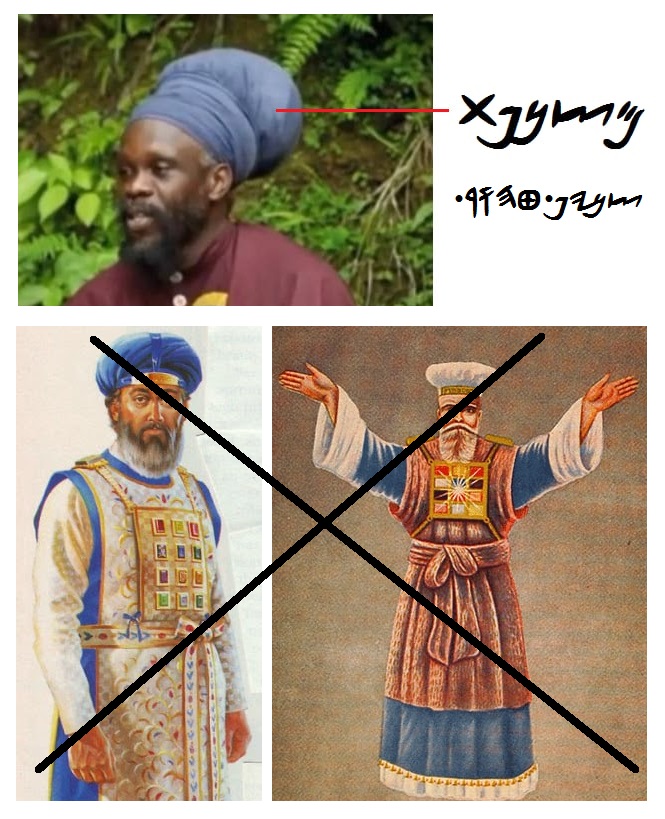
As the other men were busy changing the attire of Ya’ohshai Ban Ya’oh-tsadak the messenger of YA’OH was standing and seeing to it that all was being done aright. The acquittal is now complete, Ya’ohshai Ban Ya’oh-tsadak is now officially pardoned, and the messenger of YA’OH stands ready to give the newly installed High Priest his charge.

[6] And the messenger of YA’OH charged on Ya’ohshai saying:
[7] Thus says YA’OH tsaba’oth: If in my ways you will walk, and if my charge you will keep, then also you will judge my house, and also you will keep my court, and I will give to you places for walking between these ones who are standing.
COMMENTARY OF ZACHAR-YA’OH 3:6-7
[Verses 6-7] In the period before the Babylonian exile, the High Priest was attended by other priests who were sons of Ahran’s two surviving sons named Al-ghazar (“Al has helped”) and Ay-thamar (“island of the palm tree”). In the time of King Doayd (David) there were only eight chief men descended from Ay-thamar but sixteen were descended from Al-ghazar (1 Chron. 24:1-18), so Doayd divided the weekly priestly rotation in the tabernacle by starting with a chief son of Ay-thamar and alternating with a chief son of Al-ghazar until all eight of Ay-thamar’s descendants had served their week. These twenty-four priests are the ones who ministered to the High Priest and helped him perform his duties, and therefore they must be the unidentified men that the prophet Zachar-Ya’oh saw in his vision standing before Ya’ohshai Ban Ya’oh-tsadak. They are the ones who changed his clothes at the command of the messenger of YA’OH, and Ya’ohshai is to be given places for walking between them in the new temple of YA’OH.
Although abayonaym reject the Greek New Testament for being satanic, and Pauline Christianity for being the most satanic religion there is, the Greek gospel of Luke is at least correct in saying that the priestly house of Ab-Ya’oh (Abia) was the eighth of the twenty-four courses that rotated at the temple on a weekly basis (Luke 1:5).
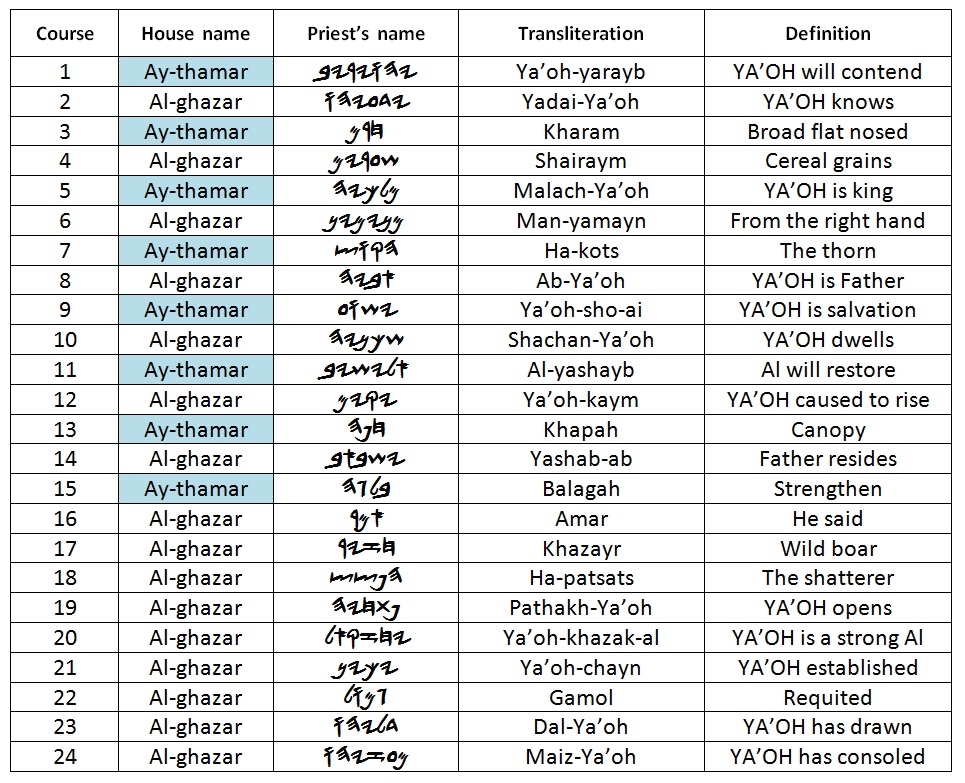
Thus, not only was Ya’ohshai Ban Ya’oh-tsadak confirmed in his office, but the whole order of the Loaym priesthood was fully restored in the days of the prophet Zachar-Ya’oh. This in keeping with the word of YA’OH in Yaram-Ya’oh 33:17-22 regarding the eternity of the royal house of Doayd, and the eternity of the Loaym priesthood. The order of the Loaym cannot be abolished. It can be punished and be put into the abeyance of a temporary timeout, but it can never abolished.
The promise made to Pay-nakhas (Phinehas), the son of Al-ghazar, in the days of old is forever, without expiration: “And it will be to him and to his seed after him a covenant of an everlasting priesthood; because of which he was jealous for his Higher Power, and he made atonement upon the sons of Ya’oh-shar-al” (Thorah 4.25:13). The satanic Greek New Testament which says otherwise in the Greek Epistle to the Hebrews 7:12-28 is a lie. Ya’ohshai Ban Ya’oh-tsadak was a direct descendant of Tsadok (1 Chronicles 6:8-15). Tsadok, a direct descendant of Pay-nakhas, was the priest to whom the promise of Pay-nakhas was re-confirmed in the days of King Shalamah (1 Sam. 2:35; 1 Kgs. 1:8; 2:27). The death of An-Ya’oh III (his name means: ‘Where is YA’OH?’), otherwise known as Onias III, in 172 BCE, marked the last of the righteous High Priests descended from the paternal line of Pay-nakhas, Tsadok, and Ya’ohshai Ban Ya’oh-tsadak.
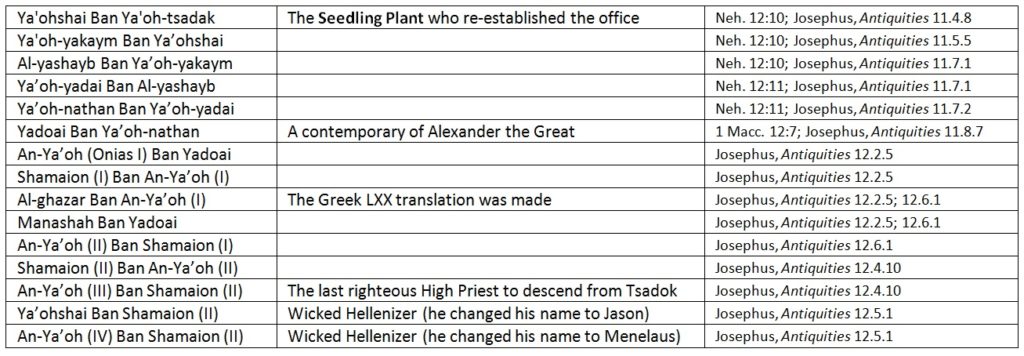
In 171 BCE, Antiochus IV Epiphanes removed the moderate pro-Hellenizer Jason, the brother of An-Ya’oh III, from being High Priest, and appointed another brother of An-Ya’oh III, the extremist pro-Hellenizer Menelaus, to be High Priest. Both of these men were wicked, and there has never been a descendant of Tsadok to hold the office of the High Priest since Menelaus was killed by Antiochus V Eupator in 162 BCE. The Hasmoneans who took up the office after Alcimus were from the house of Ya’oh-yarayb (Joarib) according to I Macc. 2:1. They were descendants of Ahran’s son Ay-thamar, not Al-ghazar, and thus the Hasmonean kings were not the correct lineage to be High Priests. In order for the promise given to Pay-nakhas to be re-confirmed and taken out of abeyance someone from the paternal lineage of Tsadok and Ya’ohshai Ban Ya’oh-tsadak has to be born and be installed as High Priest.
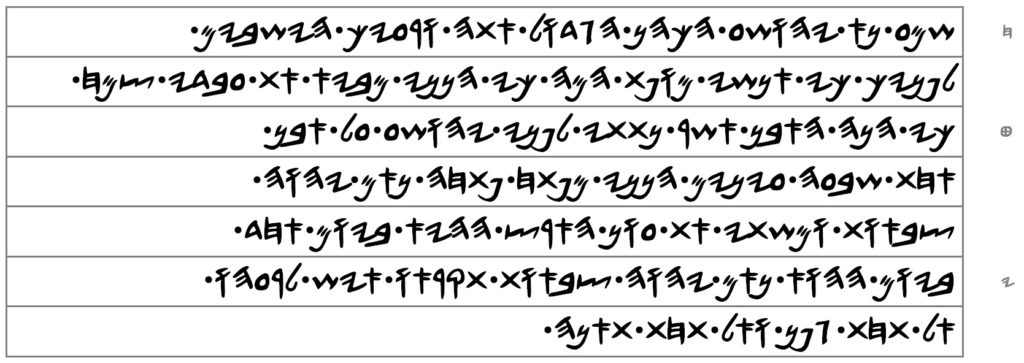
[8] Hear now Ya’ohshai, the High Priest, you and your fellows, the ones sitting before you: for men of wonder are they. For behold I am the one bringing forth my servant, the Seedling Plant.
[9] For behold the stone which I have laid before Ya’oshai. Upon one stone are seven eyes. Behold I am the engraver of the engraving thereof, says YA’OH tsaba’oth, and I will remove the iniquity of that land in one day.
[10] In that day, says YA’OH tsaba’oth, will you call each man to his fellow to underneath the vine and to underneath the fig.
COMMENTARY OF ZACHAR-YA’OH 3:8-10
[Verse 8] In verse 7, Ya’ohshai Ban Ya’oh-tsadak was given his charge and told he would have walking places between the men who re-clothed him. We have identified these men as twenty-four priests from the two houses of Al-ghazar and Ay-thamar. They had been standing before Ya’ohshai Ban Ya’oh-tsadak in the vision during his confirmation hearing, but now at conclusion of it they are seated before him on chairs. They are anashay mopath (‘men of wonder’) because the preservation of the twenty-four families during the Babylonian exile and then the restoration of the twenty-four priestly courses at the second temple was a wonder only YA’OH could perform.
For behold I am the one bringing forth my servant, the Seedling Plant. The tsamakh (‘seedling plant’) is a very young tree developing out of a plant embryo from a seed. Because seedlings are particularly vulnerable to attack by pests and diseases they are generally transplanted to a controlled environment in order to ensure their survival. This is Ya’ohshai Ban Ya’oh-tsadak who was born in exile and who later transferred to the promised land where he was installed as High Priest, re-confirming the promise given to his paternal ancestor Pay-nakhas. He is called tsamakh again in Zachar-Ya’oh 6:12 where he is told by the same prophet that he will finish building the second temple. We deduce that the priesthood cannot be restored within the lands of our exile where we were sent to be punished.
Surely the One Above All who restored the defunct office of the High Priest in the person of Ya’ohshai Ban Ya’oh-tsadak also knew that the promise He gave to Pay-nakhas would become void once again, as it did with the death of An-Ya’oh III in 172 BCE, and thus be in need of restoration once again. Since the whole nation was eventually herded into West Africa and shipped off to the land of pyramids in the New World during slavery the progeny of Ya’ohshai Ban Ya’oh-tsadak will also have to make an Exodus and migrate from the land of pyramids in the west where our curses reign supreme to the wilderness archipelago in the far east where the name YA’OH is being proclaimed by a ravenous bird and where our curses end. That is where YA’OH will revive the promise He made to Pay-nakhas and confirm a new High Priest from the lineage of Tsadok.
A righteous High Priest is coming!
The name Pay-nakhas literally means ‘the negro’ and this word and the word nigger which is derived from negro became bywords for the entire nation of Ya’oh-shar-al during slavery in the land of the pyramids in the New World. It is a display of the supreme intelligence and genius foresight of the mind of YA’OH that the future High Priest in the wilderness will be a so-called negro man honored and glorified by YA’OH just like his distant ancestor Pay-nakhas was. Our Rock will reverse our curses in the wilderness and turn His fierce anger away from us and direct it towards our enemies in the west.
[Verse 9] We are not to suppose, as the heathen interpreters do suppose from this verse, that the stone laid before Ya’ohshai Ban Ya’oh-tsadak had seven eyes looking out from it. The seven eyes are the eyes of YA’OH that run to and fro through the whole earth scanning for the man whose heart is perfect towards Him (2 Chron. 16:9; Zachar-Ya’oh 4:10). His seven eyes are now fixed upon this one stone because of the stone’s significance. It is not a literal stone of the second temple, the construction of which was being prevented by our enemies who convinced Cyrus not to enforce his own decree (Ghazar’a [Ezra] 4:5). The one stone in the vision is a metaphor for a man and all seven eyes of YA’OH are on him. There are not seven eyes peeking and staring out from a stone. The seven eyes are looking at a stone.
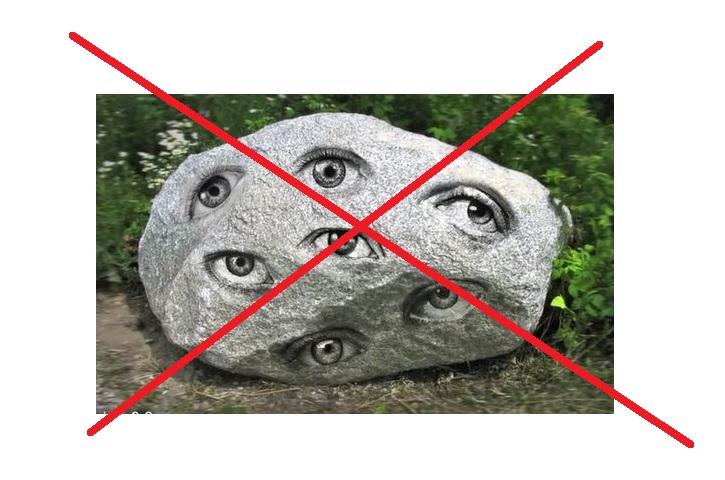
Behold I am the engraver of the engraving thereof, says YA’OH tsaba’oth. Literal building stones were often dressed and decorated with engraved designs, patterns, or inscriptions in order to beautify them. The man who the one stone represents will be figuratively engraved with an engraving by YA’OH Himself. Hence he is an important figure. YA’OH will be the one to name him.
and I will remove the iniquity of that land in one day. The heathen bible interpreters rush to conclude that the stone must be their idol Jesus Christ who they believe died on a specific day to remove the sins of humanity. If so, why is ha-arats ha-hay’a (‘that land’) still polluted with sin today? In saying ha-arats ha-hay’a it is clear that YA’OH via His prophet Zachar-Ya’oh was not talking about the land that the prophet was standing in at the time of his vision, in which case ha-arats ha-za’ath (‘this land’) is what would have been said. Just as the one stone is a metaphor for a man, that land to be cleared of iniquity in one day is a metaphor for a people to come, i.e. the remnant of Ya’oh-shar-al. The one stone is their leader the one chief (Hoshai [Hosea] 1:11), and the one day is the period of their Exodus, the great day of Ya’oh-zarai-al (‘YA’OH, the Al who plants’).
[Verse 10] This concluding verse of the vision alludes to the prophecy of May’chah (Micah) 4:1-4, which talks about the day when the house of YA’OH, the tabernacle, will be built in the top of the mountains, how people will flow to it, how YA’OH will at that time destroy strong nations far off, how nations will disarm themselves as a result and stop learning war, and how the remnant of Ya’oh-shar-al will sit confidently under the vine and under the fig tree and no one will make them afraid. Calling one’s fellow to sit with him under the vine and under the fig is an indication of the great prosperity, peace, and security that will prevail among Ya’oh-shar-al at that time after their Exodus.
None of the above came to pass in the days of Ya’ohshai Ban Ya’oh-tsadak when the building of the second temple was in progress nor since that time. So it is not logical to conclude that the one stone with seven eyes looking at it was Ya’ohshai Ban Ya’oh-tsadak the High Priest or Zarababal the governor. Nor can the one stone be the mashaykh (‘messiah’) Ya’ohshai Ban Ya’ohsap who was lynched in 34 CE, since iniquity was not removed in one day at that time, nor did the death of our brother and future king have anything whatsoever to do with atoning for anyone’s transgressions before YA’OH.
The geographical setting of May’chah 4:1-4 and the parallel passage in Yashai-Ya’oh 2:1-4 are thought by heathen interpreters to be the promised land of Ya’oh-shar-al because of May’chah 4:4 and Yashai-Ya’oh 2:3, but before the people of Ya’oh-shar-al can return to the land of their forefathers they must first have a Mount Tsayon and a Yaroshalam city in the wilderness for the period of a time, times, and a half. It is during these wonder years, when the remnant of Ya’oh-shar-al is gathered in the wilderness for their protection and safety (Yashai-Ya’oh 32:18), that YA’OH will stretch forth His hand and destroy nations afar off. It is also during these same years that many nations will become fearful of the remnant of Ya’oh-shar-al and seek to join them and to pray at the tabernacle of YA’OH (Zachar-Ya’oh 8:22-23). All of this must happen prior to the return of Ya’oh-shar-al back to the land YA’OH promised to give to their fathers and to their seed.
This vision fourth vision of the prophet Zachar-Ya’oh is about two restorations separated by more than 2,500 years. What began as a vision about Ya’ohshai Ban Ya’oh-tsadak, the tsamakh (‘seedling plant’), and his confirmation as High Priest in the days of that temporary restoration of the second temple period, concludes with a vision about a aban akhath (‘one stone’), fixated upon by the seven eyes of YA’OH, and engraved upon by Him. This is the man leading the remnant of Ya’oh-shar-al who are cleared from iniquity in the one day of their Exodus to the wilderness where they will live in safety and keep the covenant of YA’OH to the letter. We are entering that one day now and unlike the previous restoration in the 6th century BCE the restoration that is underway now will be permanent. The temple which Ya’ohshai Ban Ya’oh-tsadak finished building with Zarababal was eventually taken down by Herod the Adomay (Edomite) and replaced with Herod’s third temple (Josephus, Antiquities 15.11.1-2), but the tabernacle of YA’OH that the one stone will build in the Mount Tsayon and Yaroshalam of the wilderness will never be put to shame by being taken down by heathens (Yashai-Ya’oh 33:20).
His name is YA’OH
Always has been. Always will be.
#EXODUS2023
1.15.7252 (April 5, 2023)
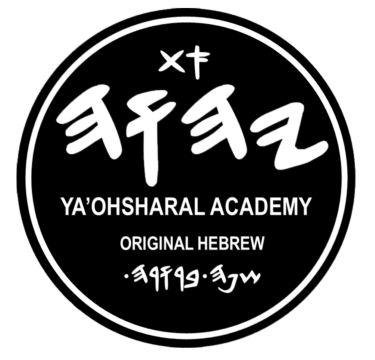
Aman wa-Aman, Chal Chabod la-YA’OH Ghalayon!!!!!!!!!!!!!!!!!!!!!!!!
AMAN